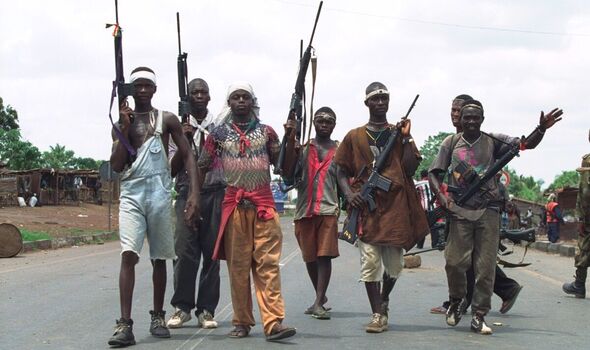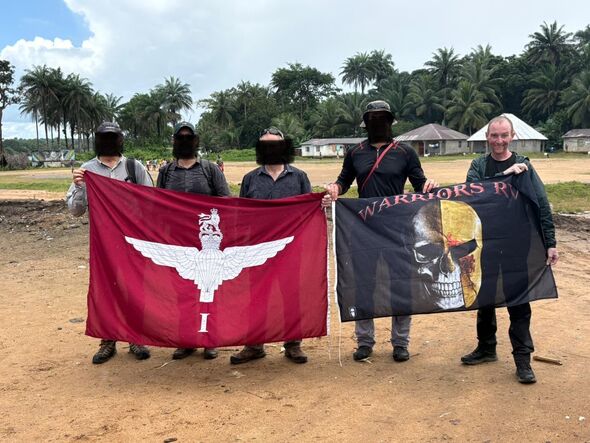
Members of the West Side Boys militia in Sierra Leone in 2000 (Image: Getty )
Within seconds they were surrounded. Hundreds of men burst from the jungle on either side of the convoy of British Army Land Rovers. Behind them, a truck mounted with a heavy machine gun covered the only route of escape. This was the moment things went horribly wrong for 11 soldiers of the Royal Irish Regiment who found themselves ambushed by militants in war-torn Sierra Leone.
The unit had been on a peacekeeping operation on August 25, 2000, when they turned down a track on their way to a remote village and came face-to-face with the notorious West Side Boys – infamous for lopping off the limbs of their enemies with machetes. Now hordes of the furious, hollering rebels had encircled the soldiers and were trying to fight them for their weapons. Army training in an ambush is to “react instantly” recalls Ian Getty, then a 20-year-old Ranger serving his first overseas deployment.
“One of my mates went to shoot, which is a pretty standard drill, but just at that moment, the Boss said ‘no’.” That call probably saved the lives of the 11 men and their local interpreter, Musa. But their fate was now in the hands of one of the most feared and unpredictable insurgent groups in Africa. What unfolded over the next 17 days would change the course of history for the West African nation and send shockwaves which still resonate to this day.
Read more: The beautiful country that’s the ‘Hawaii of Africa’ with golden beaches and 30C
Read more: Incredible map shows UK military bases around world – full list of 42 countries

Ian Getty was just 20 when his patrol was taken hostage in Sierra Leone (Image: Supplied )
It was codenamed Operation Barras and, earlier this year, a memorial was unveiled to Bombardier Bradley Tinnion, 28, who was mortally wounded while taking part in the rescue.
Back in 2000, the UK and UN were supporting and training the military of the former British colony of Sierra Leone. Then Prime Minister Tony Blair had agreed to aid the Sierra Leonean government in a brutal civil war against fighters from the Revolutionary United Front, and a breakaway faction – known as the West Side Boys.
Ian’s deployment had started off “pretty standard”, serving as “guard duty” at a camp where British troops were training the Sierra Leonean Army about 30 miles north of the capital Freetown. “All the action had been happening up country a little bit, the RUF and the West Side Boys were maniacs,” he recalls. “But they weren’t coming into Freetown or at us.”
That would change on August 25.
The ambush happened along the Rokel Creek, the largest waterway in Sierra Leone, which is bordered by thick impenetrable jungle, dangerous shifting mudflats and mangrove swamps.
Having subdued their captives, a UN helicopter flew overhead and “spooked” the WSB who transported the captured men in boats to one of their village strongholds, Gberi Bana. Ian, telling the story to mark Remembrance Sunday tomorrow, said it was “horrible” to realise he and his patrol were “not in control anymore”, but he added: “At the same time, everyone is thinking, ‘What can I do here to turn the tables?’”
All the men were put in the same three-metre-by-three-metre room in a single-story mud-baked building. It had iron bars on the windows. The tropical heat was intense, barely quenched by the heavy downpours of the rainy season. “It was a dump, we called it the White House,” recalls Ian. “That night we heard a guy being tortured to death in the room beside us, we could hear everything that was happening to him. He was actually a West Side Boy who had gone home to see his wife and kid in a village nearby, and he was unlucky to turn up on the same day we arrived – they blamed him for leading us in, which was nonsense.”

Ian with some of the rescuers who took part in Operation Barras (Image: Supplied )
Despite this, Ian and his fellow soldiers were stoic in their resolve not to show weakness, and to work out how they were going to get out of there. In those first hours and days, the erratic hierarchy of the WSB began coming up with demands for the British and the Sierra Leoneans to meet in exchange for the return of the soldiers. “They were senseless things like, ‘Tony Blair has to give us a gold bar’, or ‘Tony Blair has to free all the prisoners in Freetown in half an hour’,” recalls Ian, now 45, today.
While this was going on, the Royal Irish men faced an agonising wait for either a rescue or a similar fate to the poor soul they had heard on their first night. Over the next few days, the men were given a single tin of rice and “green stuff” to share between them. Luckily, they were allowed to keep their malaria meds and water purification tablets, perhaps a good sign, Ian thought.
“Sierra Leone rebels were famous for chopping off arms and stuff during torture,” said Ian. “Ours was more mental torture, with mock executions being a big one. They came in with a gun, kneel you down and number you off, 1,2,3,4,5… but there would be no bang.”
Around 16 civilians had also been seized by the WSB, including Musa, the patrol’s much-liked interpreter who had been thrown into a pit by their captors in a separate part of the village. When he had to engage with the WSB, Ian tried to use the international language of football to help ease the tension and show humanity.
“I’m an Everton fan and I did give some joking abuse to one of the West Side Boys wearing a Manchester United shirt. It probably wasn’t smart at the time because he turned out to be an absolute maniac,” laughs Ian. “There was another guy, we called him ‘Calm Down Fresh’, what his wife used to say to him when he was losing his mind.”
After five days, news came in that the WSB were willing to let five soldiers go in exchange for a satellite phone. Ian remembers: “The officer commanding and platoon sergeant volunteered to stay, which was absolutely immense, and then we had four privates, four rangers, we drew straws… not my best game!”
Left with the remaining six soldiers, Ian said he still had no idea a rescue might be on the way. The senior ranks, who were conducting negotiations, kept it quiet in case any hint was given away by a new mood amongst the captives. Then, on the morning of September 10, the “world exploded”. “The choppers came in… we heard the helicopter right over the top and there was gunfire and within seconds there was a guy at the door,” Ian explained.
“The bloke that kicked the door open was the calmest man I’ve ever met, he said something like ‘Morning lads, everybody good?’, and then gave a thumbs up.”

Ian with the locals now who have enjoyed years of peace (Image: Supplied )
Read more: The greatest SAS mission you’ve never heard of – told after 82 years
The hero at the door was with the SAS, who together with support from The 1st Battalion, Parachute Regiment (1 PARA), had just stormed the village. A pair of Chinook helicopters swooped in to extract them. “I think the whole rescue took about 45 minutes, we were moved to another building to wait for a helicopter, and we got back with Musa at this point. He had been so badly tortured we had to carry him,” said Ian.
“I remember sitting waiting for the helicopter and Musa was in a real panic because he thought the West Side Boys would counterattack and kill everyone. I’ve never been so confident in my life that wasn’t going to happen.”
Ian was right, the shock-and-awe of a British special forces assault was not going to be answered by the rebels. Within minutes of boarding the chopper, the Royal Irish soldiers were put “straight back to work” helping tend some injured soldiers from the Parachute Regiment. It’s estimated several dozen West Side Boys were killed. A special forces soldier was also mortally wounded.
Brad Tinnion died after being airlifted to the RFA Sir Percivale, operating alongside HMS Argyll off the coast. Heartbreakingly, his long-time girlfriend Anna Homsi was pregnant and later gave birth to their daughter, Georgia. The Royal Irish Regiment soldiers, as well as Musa, and around 16 kidnapped local civilians had all been rescued. Ian’s memory of the aftermath is still hazy.

A new memorial has been unveiled marking the heroism of those who took part in Op Barras (Image: Supplied )
But none of those soldiers ever forgot the sacrifice of Bombardier Tinnion – which Ian reveals left him wracked with guilt for the past quarter of a century. Ian, who now works with Veterans for Veterans, returned to Sierra Leone last month as part of an extraordinary 25th anniversary commemoration of Operation Barras. Rescuers and the rescued met for the first time since that fateful day.
“I had that guilt about Brad for the past 25 years,” said Ian. “But speaking with the people who rescued us, they said, ‘If he could do it again, he’d be back on the chopper’. Don’t get me wrong, it still eats at me. They said when they got to Brad he had an empty magazine, his grenade launcher was smoking, he died fighting, that’s something. Brad was a legend, that’s all I can say.”
Brad’s heroism and that of Operation Barras meant that, within days, hundreds of West Side Rebels had given themselves up to the Sierra Leonean Army. The RUF soon followed.
Ian said the response from Sierra Leoneans during his visit showed just how much Barras had achieved. “We had these meetings with the head of the Sierra Leone Army and we had dinner with the president’s representative and everyone said Op Barras changed Sierra Leone forever,” he says.
The focal point of the trip was a memorial built in honour of Brad and Operation Barras where he fell in Gberi Bana. Their former interpreter Musa, who served with the SLA, has been a driving force behind the project.
Reflecting on the years of peace and his “cathartic” return to the region, Ian said Sierra Leone now is a very different place.
“If ever you need to know the difference between 25 years ago and now, they have an Irish bar in Freetown with Guinness,” he adds.

